Elna 6001 User Manual
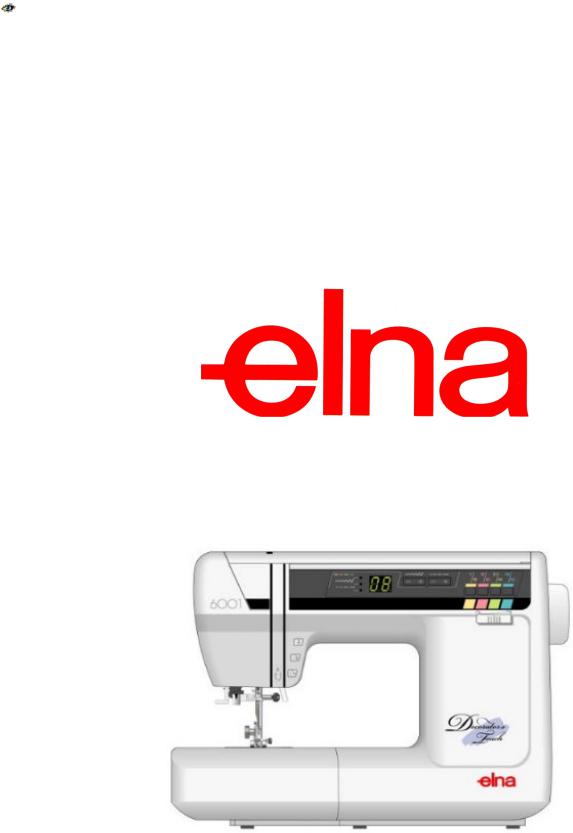
PDFMAILER.DE
INSTRUCTION BOOK
6001

PDFMAILER.DE
IMPORTANT SAFETY INSTRUCTIONS
Your Elna model 6001 sewing machine is designed and constructed for HOUSEHOLD use only. Read
all instructions before using this machine.
DANGER – To reduce the risk of electric shock:
1. Your sewing machine should never be left unattended when plugged in. Always unplug the machine from
the electrical outlet immediately after using and before cleaning.
2. Always unplug before replacing light bulb. Replace bulb with same type rated 12 Volts, 5 watts.
3. Do not reach for the machine if it has fallen into water. Unplug immediately.
4. Do not place or store machine where it can fall or be pulled into a tub or sink. Do not place it in or drop it
into water or other liquid.
WARNING – To reduce the risk of burns, fire, electrical shock or injury:
1. Do not allow machine to be used as a toy. Supervision is necessary when this machine is used by or
near children.
2. Use this sewing machine only for its intended use as described in this manual. Only use attachments
recommended by the manufacturer as described in this manual.
3. Never operate this machine if it has a damaged cord or plug, is not working properly, has been dropped
or damaged or dropped into water. Return the machine to the nearest authorized dealer or service cen-
ter for examination, repair, electrical or mechanical adjustment.
4. This machine is equipped with a special connection cord which, if damaged, must be replaced by an
identical cord. This can be obtained from your dealer.
5. Never operate the sewing machine with any air opening blocked. Keep ventilation openings of the sew-
ing machine and foot control free from the accumulation of lint, dust and fibers.
6. Never drop or insert any object into any opening.
7. Do not use outdoors.
8. Do not operate where aerosol (spray) products are being used or where oxygen is being administered.
9. To disconnect, turn machine off and remove plug from outlet.
10. Do not unplug by pulling on cord. To unplug, grasp the plug, not the cord.
11. Keep fingers away from all moving parts, especially the needle.
12. Always use the proper needle plate. The wrong plate can cause the needle to break.
13. Do not use bent needles.
14. Do not pull or push fabric while stitching. This may deflect the needle causing it to break.
15. Switch the sewing machine off when making any adjustment in the needle area, such as threading
needle, changing needle, threading bobbin, changing presser foot, etc.
16. Always unplug the sewing machine from the electrical outlet when removing covers, lubricating or mak-
ing any other servicing adjustments mentioned in the instruction manual.
SAVE THESE INSTRUCTIONS
IMPORTANT
Be sure to keep machine away from static electricity, heat sources, humidity and direct sunlight.
USA only
Your machine comes equipped with a polarized plug (one prong wider than the other). A polarized plug re-
duces the risk of electrical shock. This plug is intended to fit into a polarized outlet. If the plug does not fit
fully into the outlet, reverse the plug. If it still does not fit, contact a qualified electrician to install the proper
outlet. Do not modify the plug in any way.
Use only foot control 21249 (UL, CSA).
1

PDFMAILER.DE
TABLE OF CONTENTS
SECTION I – Machine Parts and Functions |
|
Part Names .............................................................. |
3 |
Accessory Storage ......... .......................................... |
4 |
Presser Foot Definitions .......... ................................. |
5 |
Extension Table and Free Arm .......... ........................ |
6 |
Using the Fine Adjustment Dial.......... ....................... |
6 |
How to Drop the Feed Dog ....................................... |
7 |
Foot Pressure Dial.................................................... |
7 |
Attaching and Removing Presser Feet .................... |
7 |
Attaching and Removing Shank ............................... |
7 |
Additional Presser Foot Clearance ........................... |
8 |
Seam Allowance Lines ............................................. |
8 |
Controlling Sewing Speed ......................................... |
8 |
Adjusting Needle Thread Tension ............................. |
9 |
SECTION II – Getting Ready to Sew |
|
Selecting the Correct Needle and Thread ............ |
10 |
Changing Needles ................................................. |
10 |
Needle Definitions ................................................... |
11 |
Connecting Machine to Power Supply .................. |
12 |
Main Function of Keys ...................................... |
13-15 |
Winding a Bobbin .............................................. |
16-17 |
Additional Spool Pin ............................................... |
17 |
Inserting the Bobbin ............................................... |
18 |
Threading the Machine .......................................... |
19 |
Built-in Needle Threader ........................................ |
20 |
Drawing Up the Bobbin Thread ............................. |
21 |
SECTION III – Sewing |
|
Example of How to Read the Machine Set-up |
|
Information ............................................................ |
22 |
Straight Stitch ......................................................... |
22 |
Starting to Sew ....................................................... |
22 |
Finishing Off a Seam ............................................. |
23 |
Changing Sewing Direction ................................... |
23 |
Sewing on Heavy Fabrics ...................................... |
23 |
Gathering ................................................................ |
24 |
Zipper Insertion ................................................. |
25-26 |
Pintucks .................................................................. |
27 |
Quilt Guide ............................................................. |
27 |
Rolled Hem (optional foot) ..................................... |
28 |
Twin Needle Hem ................................................... |
29 |
Zigzag Stitch .......................................................... |
30 |
Overcasting ............................................................ |
30 |
Whip and Roll Hem ................................................ |
31 |
Satin Stitch Applique .............................................. |
31 |
How to Sew on a Button ........................................ |
32 |
3-Step Zigzag ......................................................... |
33 |
Mending a Tear ....................................................... |
33 |
Blind Hem Stitches ................................................ |
34 |
Shell Tuck ............................................................... |
35 |
Box Stitch ............................................................... |
35 |
Triple Seam ............................................................ |
36 |
Saddle Stitch .......................................................... |
36 |
Stretch Seam ......................................................... |
36 |
Decorative Stretch Stitches ................................... |
37 |
Super Stretch Stitch ............................................... |
37 |
Super Overlock Stitch ............................................ |
38 |
Double Overlock Stitch .......................................... |
38 |
Buttonhole Variations ........................................ |
39-42 |
Corded Buttonhole ................................................. |
43 |
Buttonhole Applique ............................................... |
44 |
Fringing ................................................................... |
45 |
Hemstitches ............................................................ |
45 |
Drawn Work ............................................................ |
46 |
Picot Stitch ............................................................. |
46 |
Patchwork ............................................................... |
47 |
Twin Needle Decorative Stitches .......................... |
47 |
Single Pattern – Auto-Lock Key ............................ |
47 |
Scallop Edges ........................................................ |
48 |
Complete Pattern – Auto-Lock Key ....................... |
48 |
Combining Patterns ............................................... |
48 |
Smocking ................................................................ |
49 |
SECTION IV – Exclusive Optional Elna |
|
Accessories |
|
Elastic Gatherer Plate ............................................ |
50 |
Fagoting (Bridging) Plate ....................................... |
50 |
SECTION V – Taking Care of Your Machine |
|
Cleaning the Bobbin Area ...................................... |
51 |
Cleaning the Hook Area and Feed Dog ........... |
51-52 |
Replacing the Bobbin Case ................................... |
52 |
Changing the Light Bulb ........................................ |
52 |
TROUBLESHOOTING .......................... |
53 |
INDEX ................................................... |
54 |
NOTE: Information found in this instruction
manual is current at the time of printing. Elna
reserves the right to change and update specifi-
cations and information as needed.
2
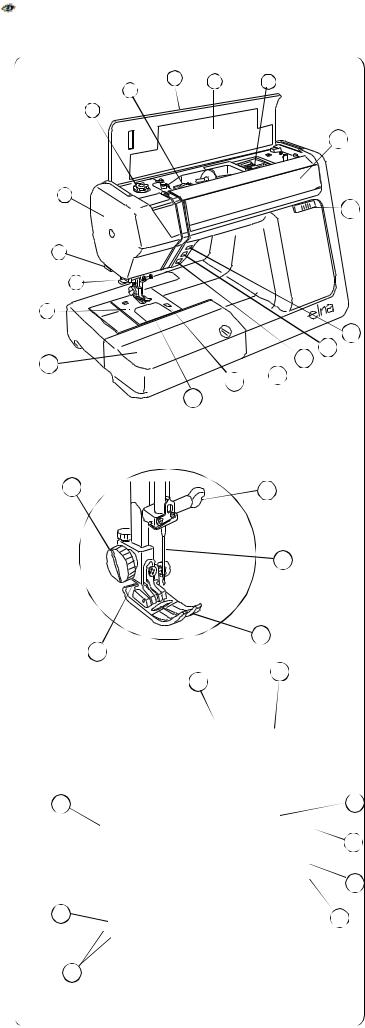
PDFMAILER.DE
SECTION I
Machine Parts and Functions
Part Names
1. Foot compartment
2. Stitch charts
3. Top cover
4. Thread tension dial
5. Foot pressure dial
6. Face plate
7. Thread cutter
8. Needle threader
9. Needle plate
10. Extension table (accessory storage box)
11. Bobbin cover plate
12. Bobbin cover plate release button
13. Fine adjustment dial
14. Reverse key
15. Auto-lock key
16. Up-down needle key
17. Speed control lever
18. Front cover (lift cover to access selection keys)
19. Needle clamp screw
20. Needle
21. Presser foot
22. Shank
23. Thumbscrew
24. Thread take-up lever
25. Carrying handle
26. Flywheel (always turn towards you)
27. Power switch
28. Machine sockets
29. Feed dog lever
30. Free arm
31. Buttonhole lever
32. Presser foot lever
3
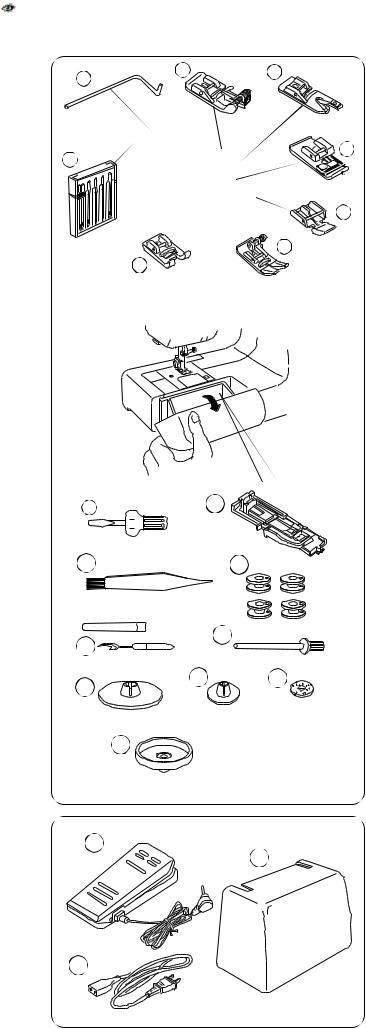
PDFMAILER.DE
Accessory Storage
Foot Compartment
1. Set of needles
2. Quilt guide
3. G: Blind hem foot
4. D: Hemmer foot (optional)
5. C: Overlock foot (optional)
6. E: Zipper foot
7. A: Standard metal foot
8. F: Satin stitch foot
Extension Table (Accessory Storage Box)
Many sewing accessories are stored in the extension
table. Pull lid towards you to open the storage box.
9. |
Screwdriver |
10. |
R: Automatic buttonhole foot |
11. |
Lint brush |
12. |
Bobbins (5 total) |
13. |
Seam ripper |
14. |
Large spool holder |
15. |
Small spool holder |
16. |
Additional spool pin |
17. |
Spool pin felt |
18. |
Spool stand |
19. Foot control
20. Power supply cord
21. Carrying case
4
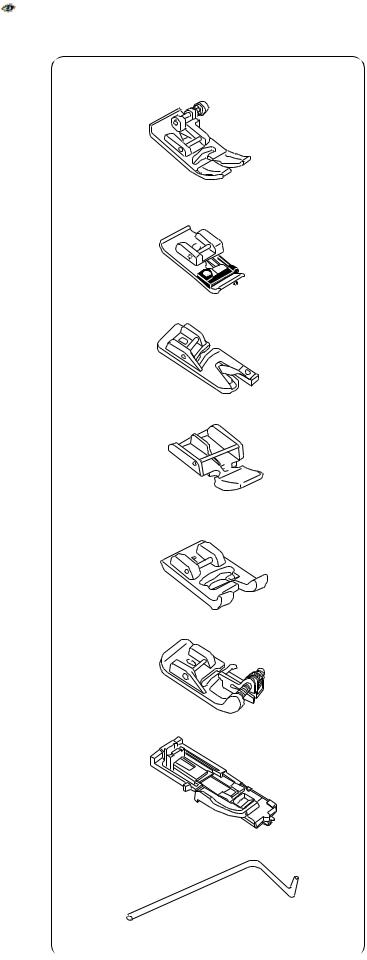
PDFMAILER.DE
Presser Foot Definitions
A: STANDARD METAL FOOT A
This foot comes attached to your machine. It is
mainly used for straight stitches and zigzag stitches
longer than 1.0. The button locks the foot in a hori-
zontal position helping to sew over multiple layered
seams.
C: OVERLOCK FOOT (optional)
Prevent fabric edges from raveling by finishing the
edge with a zigzag stitch. The brush on the foot
helps the stitch lie flatter and reduces puckering. Use
with medium weight fabrics.
D: HEMMER FOOT (optional)
Insert the fabric into the spiral on this foot. The spiral
rolls the fabric, creating a rolled hem. An easy, pro-
fessional way to sew hems.
E: ZIPPER FOOT
Use when sewing zippers into place to avoid the foot
riding on top of the zipper coil. Attach either to the
left or right of the needle to sew each side of the zip-
per.
F: SATIN STITCH FOOT
The cutout on the underside of the foot is designed
to accommodate dense stitch formation. Ideal when
sewing satin and decorative stitches.
G: BLIND HEM FOOT, ADJUSTABLE
The adjustable guide on the foot helps ensure that
the needle catches only one or two fibers of the
hem, resulting in an invisible hemline. The guide can
also be adjusted to create pintucks.
R: AUTOMATIC BUTTONHOLE FOOT
Place button in foot to determine the buttonhole size.
The machine will automatically sew the correspond-
ing buttonhole.
QUILT GUIDE
The quilt guide is helpful when sewing parallel,
evenly spaced rows of stitching.
5
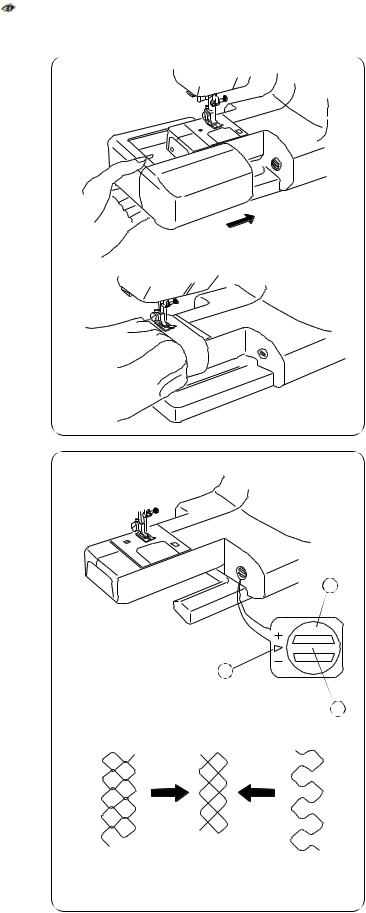
PDFMAILER.DE
Extension Table (Accessory Storage Box)
and Free Arm
Extension Table
The extension table provides more sewing space to
make sewing easier. The extension can be easily
removed for free arm sewing.
Free arm sewing is good for circle areas like sleeves,
waistbands and pant legs. If socks, knee or elbow
areas need mending, the free arm will be best to
use.
Pull the end of the extension table away from the
machine, as shown in the drawing.
Push the table back into place to reattach the exten-
sion table.
Using the Fine Adjustment Dial
Choice of fabrics and threads may affect the stitch
formation when sewing decorative stitches or button-
holes. The fine adjustment dial can be used to either
lengthen or shorten the stitch.
j Fine adjustment dial
k Standard mark
• Setting mark
To fine tune, use a screwdriver to move the setting
mark.
∙ If stitches are too short m, correct by turning the
dial in the direction of “+”.
∙ If stitches are too short n, correct by turning the
dial in the direction of “-.”
∙ If left side of buttonhole is less dense o than
right side, correct by turning dial in direction of
“+”.
∙ If right side of buttonhole is less dense p than
left side, correct by turning dial in direction of “-.”
6
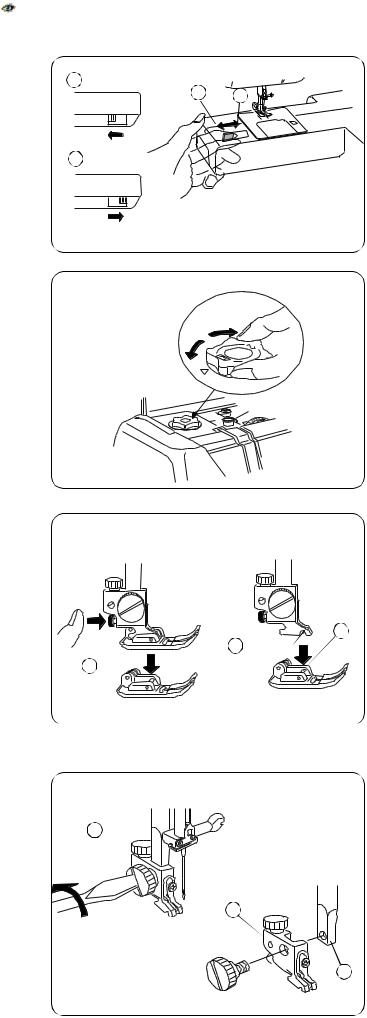
PDFMAILER.DE
How To Drop the Feed Dog
The feed dog drops out of position for special sewing
techniques: free motion embroidery, button sewing,
etc.
The feed dog must always be up for regular sewing.
Locate the feed dog lever on the back of the free
arm. Slide the lever either to the right (down) j or to
the left (up) k. To bring up the feed dog, hand turn
the flywheel after sliding lever to the left.
Foot Pressure Dial
Set the pressure dial j at “3” for regular sewing.
Reduce the pressure to “2” for applique, cutwork,
drawn work, basting and embroidery.
Velours and knits with a lot of stretch may require a
“1” setting.
Attaching and Removing Presser Feet
Press the key until the needle is in the raised posi-
tion. Raise the presser foot and press the red button
j on back of the shank. The presser foot will drop
off. Place the selected presser foot so the pin • on
the foot lies just under the groove k of the shank.
Lower the presser bar to attach the foot.
Attaching and Removing Shank
Turn the thumbscrew j counterclockwise with the
screwdriver to remove the shank.
To attach, match the hole in the shank k with the
hole in the presser bar •. Put thumbscrew in hole
and turn clockwise to tighten.
7
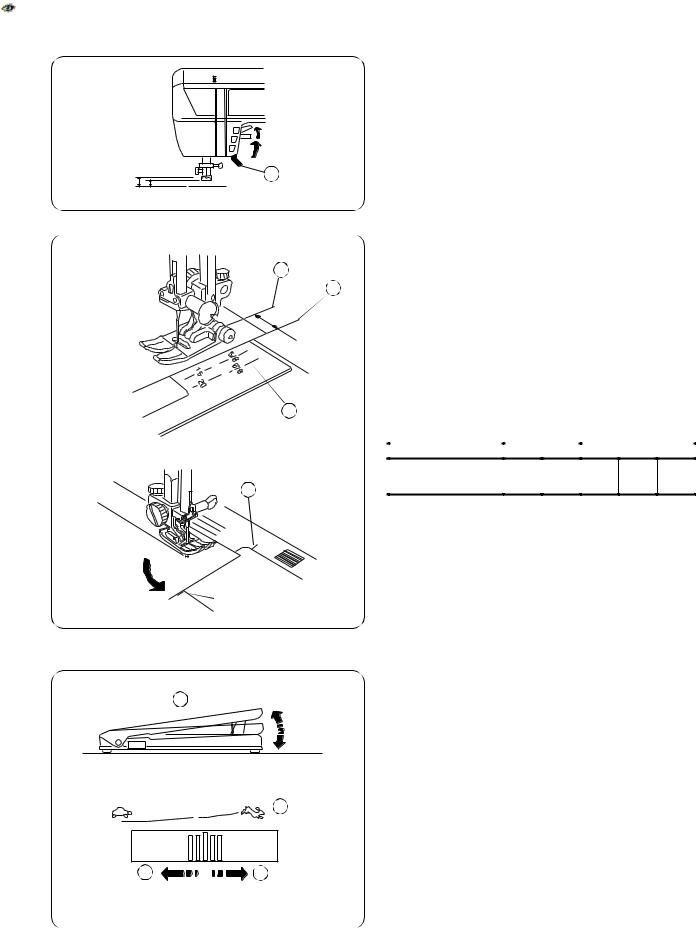
PDFMAILER.DE
Additional Presser Foot Clearance
You can raise the presser foot about 6.5 mm (1/4”)
higher than the normal up position for easy removal
of the presser foot or to place heavy fabrics under
the presser foot. Pull the presser foot lever • up be-
yond the normal up position.
Seam Allowance Lines
The lines on the needle plate and bobbin cover plate
help you measure seam width.
The number indicates the distance between the cen-
ter needle position 3.5 and the seam allowance line.
|
Millimeters |
|
Inches |
|
|
Lines on needle |
15 |
20 |
(1/2”) |
5/8” |
(3/4”) |
plate |
4/8” |
|
6/8” |
||
|
|
|
|
|
|
• Center needle position
‚ Edge of fabric
ƒ Needle plate guidelines
„ 90° pivot angle guideline for 5/8”
Controlling Sewing Speed
Sewing speed can be varied with the foot control •.
The harder you press on the foot control, the faster
the machine runs.
The maximum sewing speed can be varied by sliding
the speed control lever ‚ . For a faster speed ƒ ,
slide it to the right; for a slower speed
the left.
8
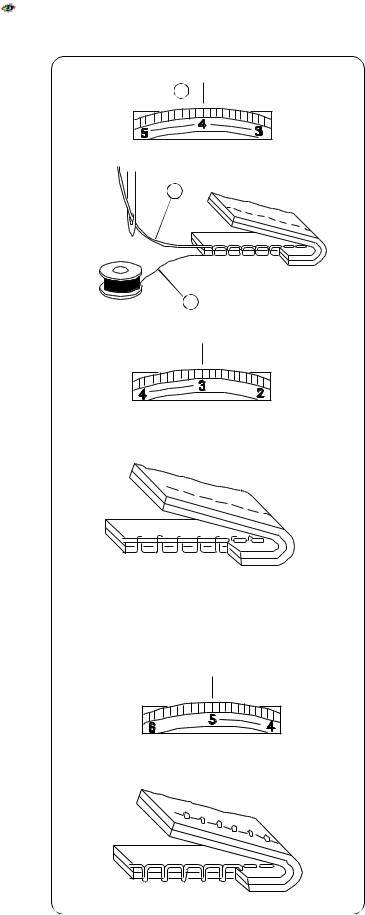
PDFMAILER.DE
Adjusting the Needle Thread Tension
Choosing the Correct Tension - Straight Stitch
The ideal straight stitch will have threads locked be-
tween the two layers of fabric, as shown left (magni-
fied to show detail). Needle thread tension can range
from 3 – 5 and is normally set on 4 j.
If you look at the needle thread k (top thread) and
bobbin thread • (bottom thread), you will notice that
there are no gaps. Each stitch is smooth and even.
Occasionally the needle thread tension needs to be
adjusted. Examples:
− stiff or heavy fabric
− sewing more than two layers of fabric
− type of stitch
− thread
When adjusting needle thread tension, the higher
numbers tighten, the lower numbers loosen.
∙ Tension is too tight
The bobbin thread shows through on the topside of
the fabric and it will feel bumpy.
Turn the dial to a lower number to loosen the needle
thread tension.
∙ Tension is too loose
The needle thread shows through on the underside
of the fabric and it will feel bumpy.
Turn the dial to a higher number to tighten the
needle thread tension.
∙ Adjusting Tension for Zigzag and Satin
Stitches
The upper thread tension should be slightly looser
when sewing a zigzag or a satin stitch. The upper
thread should appear slightly on the underside of the
fabric.
9
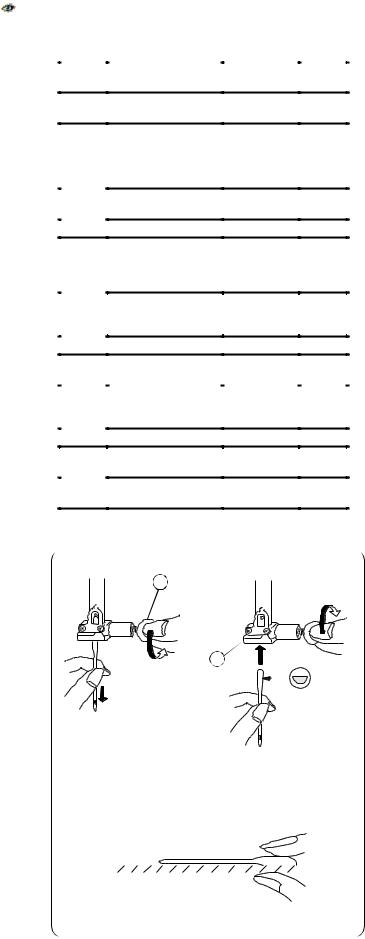
PDFMAILER.DE
Weight |
|
|
|
Fabric |
Needle Type |
|
Needle |
||||||
|
|
|
|
|
|
|
|
|
|
|
|
|
Size |
Very |
Chiffon, Fine Lace, |
Universal |
9 (65) |
||||||||||
Light |
Organdy |
Ball Point |
9 (65) |
||||||||||
Light |
Batiste, Lawn, Crepe |
Stretch |
11 (75) |
||||||||||
|
|
|
de Chine, Challis |
|
|
|
|
|
|
|
|||
|
|
|
Handkerchief Linen, |
|
|
|
|
|
|
|
|||
|
|
|
Crepe, Taffeta, Satin |
Universal |
11 (75) |
||||||||
|
|
|
|
|
|
|
|
|
|
|
|
12 (80) |
|
|
|
|
Single Knits, Jersey, |
Stretch |
11 (75) |
||||||||
|
|
|
Swimwear, Tricot |
Ball Point |
11 (75) |
||||||||
|
|
|
Leather, Suede |
Leather |
11 (75) |
||||||||
Medium |
Flannel, Velour, Velvet, |
Universal |
14 (90) |
||||||||||
|
|
|
Velveteen, Corduroy, |
|
|
|
|
|
|
|
|||
|
|
|
Linen, Gabardine, |
|
|
|
|
|
|
|
|||
|
|
|
Wool, Terry, Burlap |
|
|
|
|
|
|
|
|||
|
|
|
Double Knits, Stretch |
Ball Point |
14 (90) |
||||||||
|
|
|
Velour, Stretch Terry, |
|
|
|
|
|
|
|
|||
|
|
|
Sweater Knits |
|
|
|
|
|
|
|
|||
|
|
|
Leather, Vinyl, Suede |
Leather |
14 (90) |
||||||||
Heavy |
Denim, Sailcloth, |
Denim |
16 (100) |
||||||||||
|
|
|
Ticking |
|
|
|
|
|
|
|
|||
|
|
|
|
|
|
|
|
|
|
|
|
|
|
|
|
|
Coating, Polar Fleece, |
Universal |
16 (100) |
||||||||
|
|
|
Drapery and |
|
|
|
|
|
|
|
|||
|
|
|
Upholstery Fabrics |
|
|
|
|
|
|
|
|||
|
|
|
Leather, Suede |
Leather |
16 (100) |
||||||||
Very |
Canvas, Duck, |
Universal |
18 (110) |
||||||||||
Heavy |
Upholstery Fabrics |
|
|
|
|
|
|
|
|||||
|
|
|
Topstitching for |
Topstitching |
11 (75) |
||||||||
|
|
|
Special Finish |
|
|
|
|
|
14 (90) |
||||
|
|
|
|
|
|
|
|
|
|
|
|
|
|
|
|
|
|
|
|
|
|
|
|
|
|
|
|
|
|
|
|
|
|
|
|
|
|
|
|
|
|
|
|
|
|
|
|
|
|
|
|
|
|
|
|
|
|
|
|
|
|
|
|
|
|
|
|
|
|
|
|
|
|
|
|
|
|
|
|
|
|
|
|
|
|
|
|
|
|
|
|
|
|
|
|
|
|
|
|
|
|
|
|
|
|
|
|
|
|
|
|
|
|
|
|
|
|
|
|
|
|
|
|
|
|
|
|
|
|
|
|
|
|
|
|
|
|
|
|
|
|
|
|
|
|
|
|
|
|
|
|
|
|
|
|
|
|
|
|
|
|
|
|
|
|
|
|
|
|
|
|
|
|
|
|
|
|
|
|
|
|
|
|
|
|
|
|
|
|
|
|
|
|
|
|
|
|
|
|
|
|
|
|
|
|
|
|
|
|
SECTION II
Getting Ready to Sew
Selecting the Correct Needle and Thread
There are many kinds of fabrics, threads and
needles. It is important to use the correct ones to-
gether.
Always purchase good quality thread. It should be
strong, smooth and even in thickness. Use the same
thread for needle and bobbin. Always test thread and
needle size on a scrap piece of fabric.
In general, fine threads (the larger the number, the
finer the thread) and needles (the smaller the num-
ber, the finer the needle) are used for sewing light-
weight fabrics and heavier threads and larger
needles are used for sewing heavyweight fabrics.
There are many specialty needles available from
your sewing machine dealer.
Check your needles frequently for rough or blunt
tips. Snags and runs in knits, fine silks and silk-like
fabrics are permanent and are often caused by dam-
aged needles.
Changing Needles
1. Press the needle key to raise the needle.
Lower the presser foot. Turn off the power
switch. Turn the needle clamp screw • counter-
clockwise to loosen.
2. Remove the needle from the clamp. Insert the
new needle into needle clamp ‚ with the flat
side to the back, pushing it up as far as it will go.
Tighten the clamp screw firmly.
3. To determine if the needle is defective, place the
flat side of the needle on something flat
(a needle plate, piece of glass, etc.). The gap
between the needle and the flat surface should
be consistent.
Never use a bent or blunt needle, as it may
cause skipped stitches or thread breakage. De-
fective needles can ruin the fabric. Always pur-
chase good quality needles. Change needles
often.
10

PDFMAILER.DE
Needle Definitions
The illustration identifies the main parts of a sewing
machine needle.
1. Body
2. Shaft
3. Long groove (round side of needle)
4. Short groove (flat side of needle)
5. Eye
6. Point
2
3
4
5
6
Universal – an all-purpose needle that handles most
woven and knit fabrics. A universal needle size 14/90
comes inserted in your machine.
Ball point – the point spreads the fibers, preventing
tears and is especially suited for knit fabrics. Not
recommended for embroidery.
Denim – the sharp point effectively pierces densely
woven fabrics such as denim and canvas.
Stretch – specially designed to prevent skipped
stitches in synthetic suedes and elasticized knits
(swimwear).
Leather – the cutting point creates small holes in
leather and suede.
Topstitching – the extra sharp point penetrates layers
of fabrics; extra large eye and large groove accom-
modate heavyweight topstitching thread.
Twin/Double – 2 needles are joined on a crossbar
and share a single shaft. Sews two parallel rows of
stitching. Available in universal and ballpoint.
11
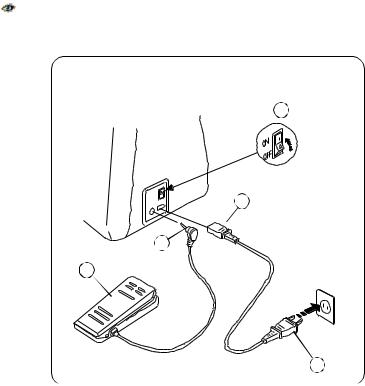
PDFMAILER.DE
Connecting Machine To Power Supply
Before connecting the power cord, make sure the
voltage and frequency shown on the machine are
identical to your electrical power.
To connect the foot control … , turn off the power
switch „ . Insert the foot control plug • and machine
plug ‚ into the machine and the power supply plug
ƒ into the wall socket.
Your machine may come equipped with a polarized
plug (one prong wider than the other). A polarized
plug reduces the risk of electrical shock. This plug is
intended to fit into a polarized outlet. If the plug does
not fit fully into the outlet, reverse the plug. If it still
does not fit, contact a qualified electrician to install
the proper outlet. Do not modify the plug in any way.
IMPORTANT: When using your sewing machine the
first few times, place waste fabric under the presser
foot and run the machine without thread for a few
minutes. Wipe away excess oil.
For Your Safety
Do not use extension cords or plug adapters.
Do not touch plug with wet hands.
Always turn off the power/light switch first and then
unplug from the electrical outlet. Examples:
∙ when leaving the machine unattended
∙ when cleaning the machine
Always turn off the power/light switch:
∙ when attaching or removing parts such as
needle, presser foot, needle plate
∙ when threading needle or bobbin
Do not place anything on the foot control.
Do not place heavy items on cords. Do not subject
cords to heat. Do not use damaged cords. Have the
cord repaired immediately.
While the machine is in operation, always keep your
eye on the sewing area and do not touch any mov-
ing parts such as the thread take-up lever, flywheel
or needle.
12
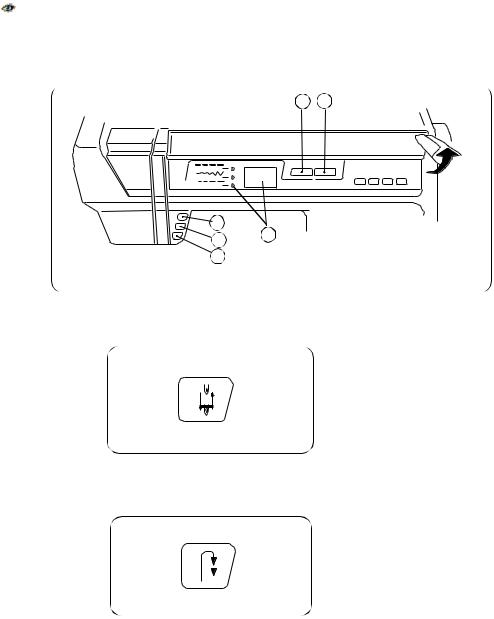
PDFMAILER.DE
Main Function
Lift front cover up and
away to reveal the
Selection Keys and LED
readout.
Switch on the machine.
(Test lights run in LED
readout.)
1. Up/Down Needle Key
If the needle is up when you press this key, the
needle will go down to its lowest position. The
needle will continue to stop in the down position.
If the needle is down when you press this key,
the needle will go to its highest position. The
needle will continue to stop in the up position.
2. Auto-Lock Key
Press this key while sewing a straight stitch, zig-
zag stitch or 3-step zigzag stitch and the ma-
chine will sew a few stitches in place and stop
automatically.
* Press this key while sewing utility or decorative
stitches and the machine will complete the stitch,
lockstitch and stop.
13

PDFMAILER.DE
3. Reverse Key
If you are sewing a straight stitch, zigzag stitch
or 3-step zigzag stitch, press and hold this key.
The machine will sew in reverse until you release
the key.
|
|
|
|
|
* If you are sewing utility or decorative stitches, |
|
1 |
16 |
31 |
46 |
|
the machine will immediately stop and sew a |
|
|
15 |
30 |
45 |
60 |
locking stitch when you press this key. |
|
|
|
|
|
|
4. Indicator Lights and LED Readout |
|
|
|
|
|
|
a. When this light is lit, the readout displays the |
|
|
|
|
|
|
|
selected stitch. |
|
|
|
|
|
b. When this light is lit, the readout displays the |
|
|
|
|
|
|
|
selected stitch width/needle position. |
|
|
|
|
|
c. |
When this light is lit, the readout displays the |
|
|
|
|
|
|
selected stitch length. |
5. Stitch Width and Needle Position Key
Press this key to display pre-programmed stitch
width or needle position.
To decrease stitch width or move needle position
to the left, press – side of key.
To increase stitch width or move needle position
to the right, press + side of key.
The stitches listed below allow you to move the
needle to any position by pressing the – or +
side of the key. There are 15 needle positions for
straight stitches (0.0 – 7.0).
a Left position
b Center position
c Right position
14
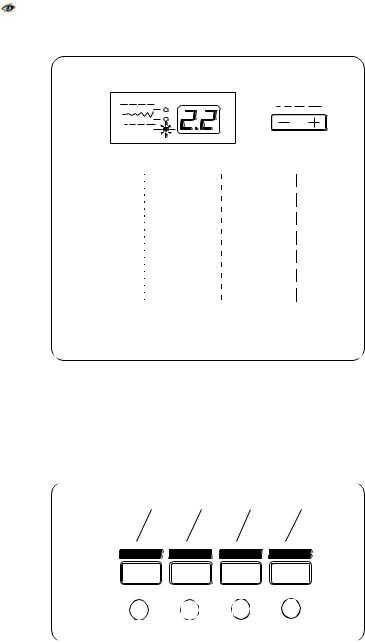
PDFMAILER.DE
6. Stitch Length Key
Press this key to display pre-programmed stitch
length.
Depending on the stitch selected, stitch length
can be set between 0.0 and 5.0.
To decrease stitch length, press – side of key.
To increase stitch length, press + side of key.
∙ The reverse stitch length will not sew any longer
than 2.5 mm (approx. 1/8”).
NOTE: Fine fabrics should have a stitch length be-
tween 1.5 and 2.5, medium fabrics between 2.0 and
3.0 and heavier fabrics between 3.0 and 4.0.
|
|
|
|
7. |
Stitch Selection Keys |
|
1 |
16 |
|
31 |
46 |
a. |
Press and hold this key to access |
|
15 |
30 |
45 |
60 |
|
stitches 1 – 15. |
|
b. |
Press and hold this key to access |
||||
|
|
|
|
|
||
|
|
|
|
|
|
stitches 16 – 30. |
|
|
|
|
|
c. |
Press and hold this key to access |
|
|
|
|
|
|
stitches 31 – 45. |
|
|
|
|
|
d. Press and hold this key to access |
|
|
|
|
|
|
|
stitches 46 – 60. |
15
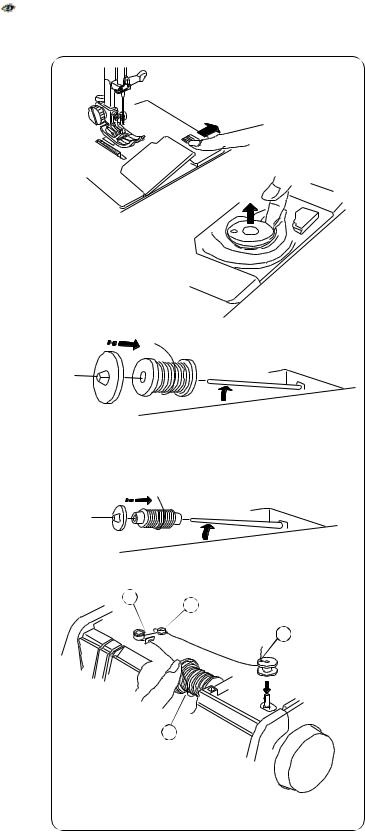
PDFMAILER.DE
Winding a Bobbin
To remove bobbin, slide bobbin cover plate release
button to the right and lift away the bobbin cover
plate.
Lift out the bobbin.
• Lift up the spool pin. Place the spool of thread on
the spool pin with the thread coming off the spool
as shown. Attach the spool holder and press it
firmly against the spool of thread.
NOTE: Spool holder needs to be changed according
to the type of thread spool
A. Large spool
B. Small spool
kPull the thread towards the thread guides, under
2
the hook and wrap it around the guide as shown.
3
4
•Pull the thread back around the bobbin winder
thread guide.
mPass the thread through the hole in the bobbin
from inside to the outside.
16
